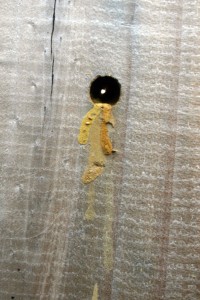
Contrary to what some people may believe, carpenter bees don’t actually eat wood, but instead they chew through it with their powerful mandibles. In most cases, homeowners will notice a pile of sawdust at the bottom of a tunnel. If a carpenter bee is still devouring wood inside the tunnel, you’ll probably notice more sawdust falling onto the ground. Typically, they either spit out the particles of wood or use them to create partitions where individual bees can nest.
Problems Creates By Carpenter Bee Infestations In The Attic
There are several reasons why you don’t want a carpenter bee infestation in your attic, one of which is the paths they create for thermal energy to escape. A standard carpenter bee tunnel is approximately 0.67 inches wide, which is plenty of room for thermal energy to escape. Each hole offers the perfect area for thermal energy to escape from your home, jacking up your power and/or gas bill. Considering the fact that most infestations result in half a dozen or more ‘main’ tunnels, you can see how much of a problem they are.
You can read through our previous blog post here for more tips on how to create an energy-efficient home.
Removing Carpenter Bees
If you believe your attic is infested with carpenter bees, you should take action immediately to remove them. There are several different techniques used for treating carpenter bee infestations, but one of the easiest methods is to spray a high-grade pesticide directly into their tunnels. Assuming the tunnels are still relatively small and undeveloped, pesticide should make its way up to the bee.
Re-painting the exterior of your home may also offer some protection against carpenter bees. Although it won’t completely stop them from burrowing, carpenter bees prefer to burrow in unpainted wood. Keeping a fresh coat of paint on your home’s exterior will discourage carpenter bees from burrowing new tunnels.

